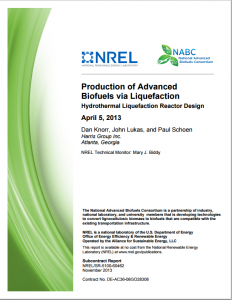Full Title: Production of Advanced Biofuels via Liquefaction Hydrothermal Liquefaction Reactor Design
Author(s): Dan Knorr, John Lukas, and Paul Schoen
Publisher(s): National Renewable Energy Laboratory (NREL)
Publication Date: April 1, 2013
Full Text: Download Resource
Description (excerpt):
National Renewable Energy Laboratory (NREL) in Golden, Colorado, contracted with Harris Group Inc. (Harris Group) to develop detailed reactor designs and capital cost and operating cost estimates for the hydrothermal liquefaction reactor system under development at Pacific Northwest National Laboratories (PNNL). The goal of the design and costing efforts was to provide guidance on the expected cost of the reactor systems as well as to highlight areas where research efforts could reduce project costs.
The primary challenges associated with the reactor section design were (1) maximizing heat integration, (2) managing the potential for poor heat transfer from the reactor effluent to the reactor feed due to the potential for high viscosities in the feed streams, and (3) minimizing cost associated with the reactor system itself, given the very high required pressures. As such, five cases were developed to try to address these challenges. In Case A, a recycle stream already at reactor temperature is immediately contacted with the feed from the feed pumps to provide indirect heating. This results in a feed stream at sufficiently high temperatures to avoid high viscosity in the feed and the corresponding low heat transfer coefficients. In Case B, feed is pumped and heated through a series of pre-heaters prior to a final trim heating in a hot-oil heater prior to entering a reactor to maximize heat integration. Unfortunately, the expected heat transfer coefficients for Case B are quite low, resulting in large heat exchanger area requirements. Another case, Case D, was selected to explore the possibility that the feed pumps would be able to handle a high solid loading of 36.6 wt% dry solids. This allows the majority of the desired recycle water, which is at reactor temperatures, to be added just downstream of the pumps resulting in a feed stream at sufficiently high temperatures to avoid high viscosity in the feed and the corresponding low heat transfer coefficients. Cases B-L and D-L were variations of Cases B and D wherein the separation unit operation downstream of the reactor required low temperature operation. All cases were designed for a feed rate of 2000 dry metric tons of wood chips per day.
